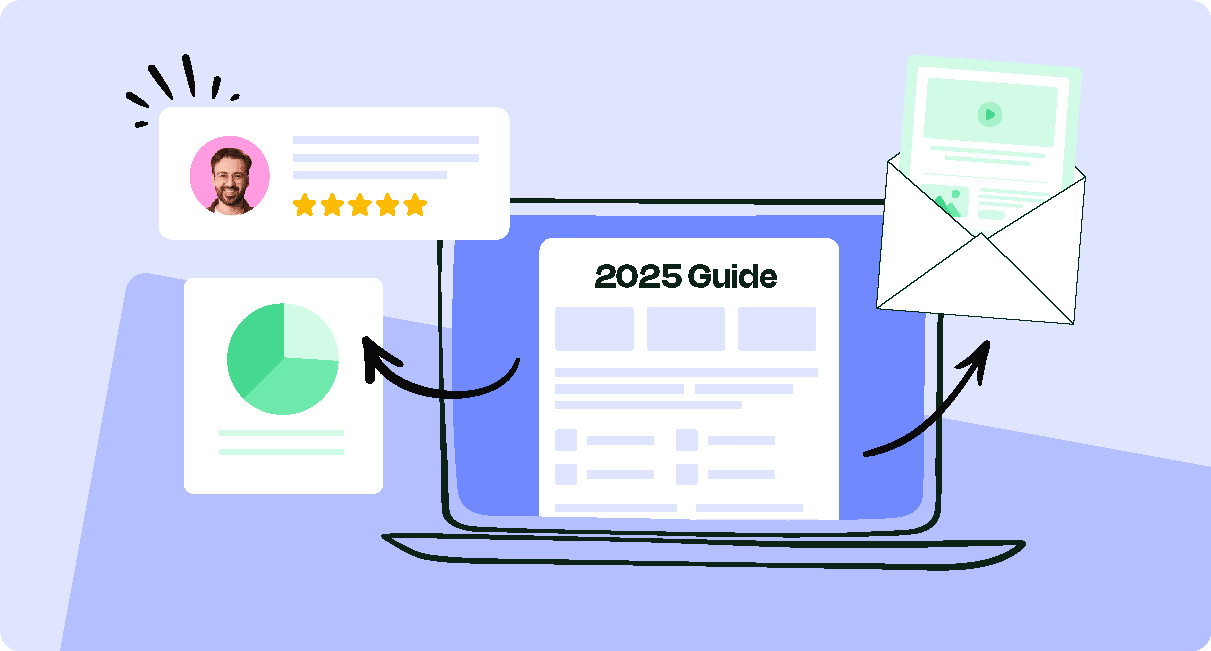As an internal communicator, your employees are your internal audience. They scan emails, click links, ignore some messages, and obsess over others. And just like customers, their behavior can tell you what’s working—and what’s being tuned out. Use this post to narrow down which employee engagement KPIs you should focus on.
Marketers don’t guess. They track open rates, clicks, bounce rates, and conversions. They A/B test subject lines, analyze heatmaps, and study audience behavior like scientists—because they know that what gets measured gets improved. So why should measuring employee behaviour be any different? This is why employee engagement KPIs exist, similar to marketing KPIs.
By treating engagement like a measurable system, internal communicators can gain real insight into how employees feel, what motivates them, and where communication is falling flat.
This guide breaks down the most valuable employee engagement KPI examples to monitor in 2025, how to measure them using internal communication tools, and how to improve each one to build a more connected, informed, and motivated workforce.
See how ContactMonkey’s analytics features make it super easy to track your employee engagement KPI’s and metrics.
Take a self-guided tour of ContactMonkey
See how our key features can streamline your internal communications.
Take product tour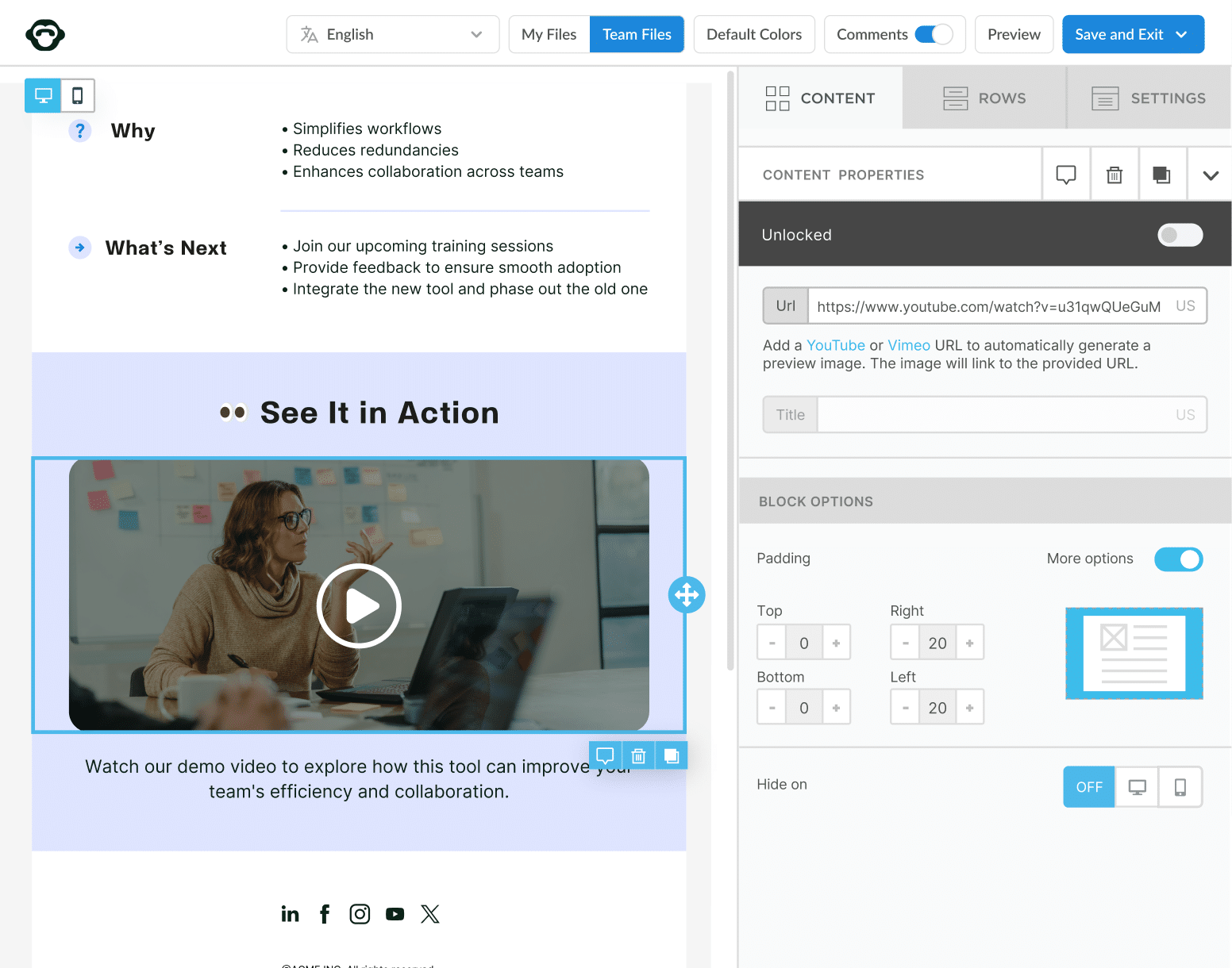
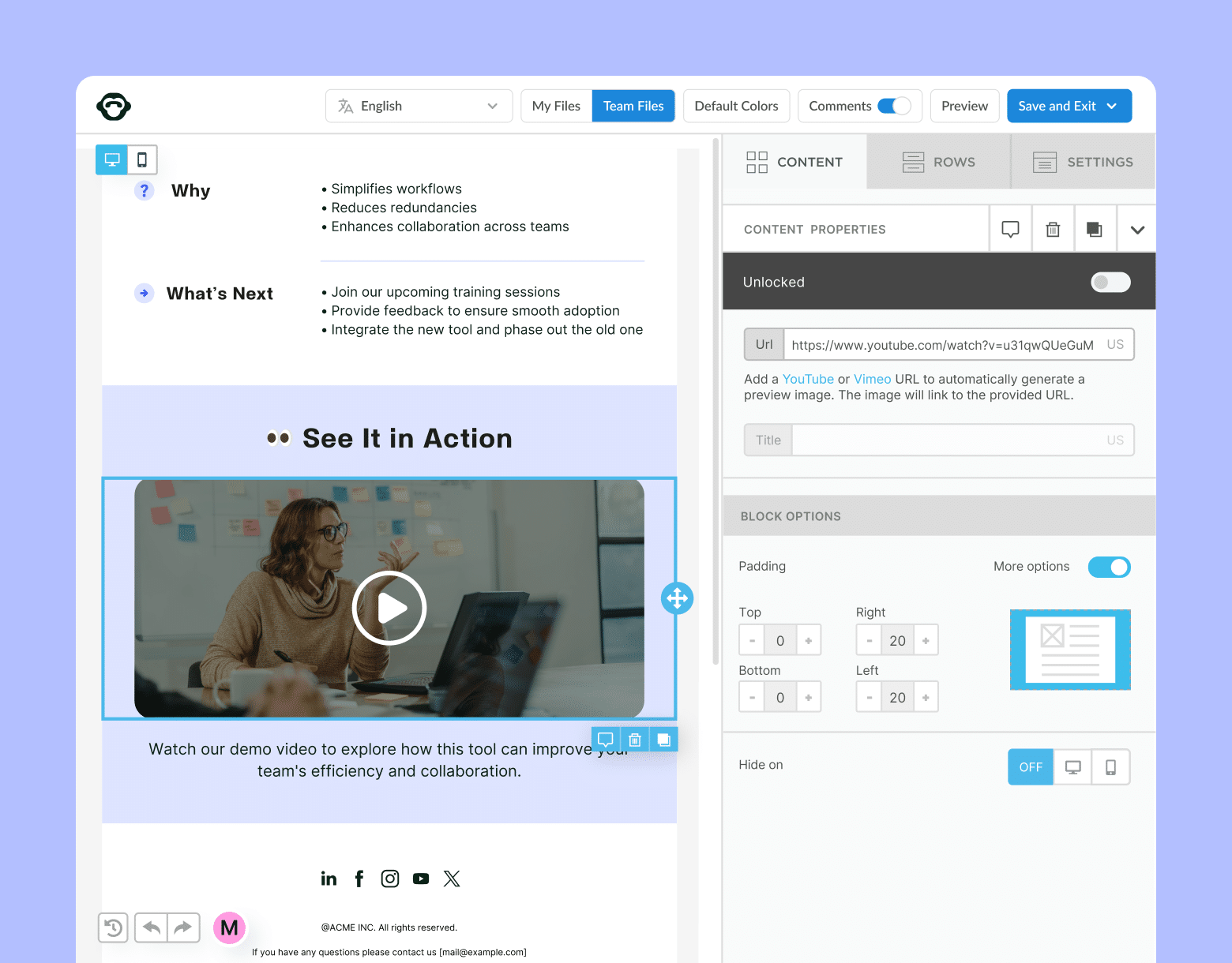
Why is Employee Engagement so Important in 2025?
Disengaged employees cost companies real money. According to Gallup’s 2025 report, businesses with high employee engagement see 23% higher profitability and 81% lower absenteeism.
Here’s the kicker: only 23% of employees globally are actively engaged at work, while a staggering 62% are not engaged and 15% are actively disengaged.
In 2025, the importance of employee engagement is amplified by:
- Remote and hybrid work: Connection is harder to build and maintain.
- Generational shifts: Each cohort expects a different kind of employee experience.
- Economic pressure: Every dollar spent needs to show ROI. Fast.
So, why is employee engagement important? Engaged employees perform better, stay longer, and bring others up with them. That’s the real benefit of employee engagement. And it’s why tracking it with the right employee engagement KPIs matters more than ever.
What Are Employee Engagement KPIs?
Employee engagement KPIs are measurable indicators that show how emotionally committed, motivated, and connected employees are to their work and organization. These key performance indicators help internal communicators and HR teams track and improve engagement over time.
Common employee engagement KPI examples include:
- Employee Net Promoter Score (eNPS): Measures willingness to recommend the company.
- Employee engagement survey KPI participation: Reflects how involved employees are in feedback loops.
- Absenteeism, turnover, or burnout rates: Signal potential disengagement or retention risks.
These metrics act like a dashboard for your workplace. They don’t explain everything, but they highlight where to dig deeper—and where your internal communication strategy may need to shift.
Get powerful email analytics and reporting features
Know exactly who is opening and engaging with your employee communications and company newsletters.
Explore analytics & reporting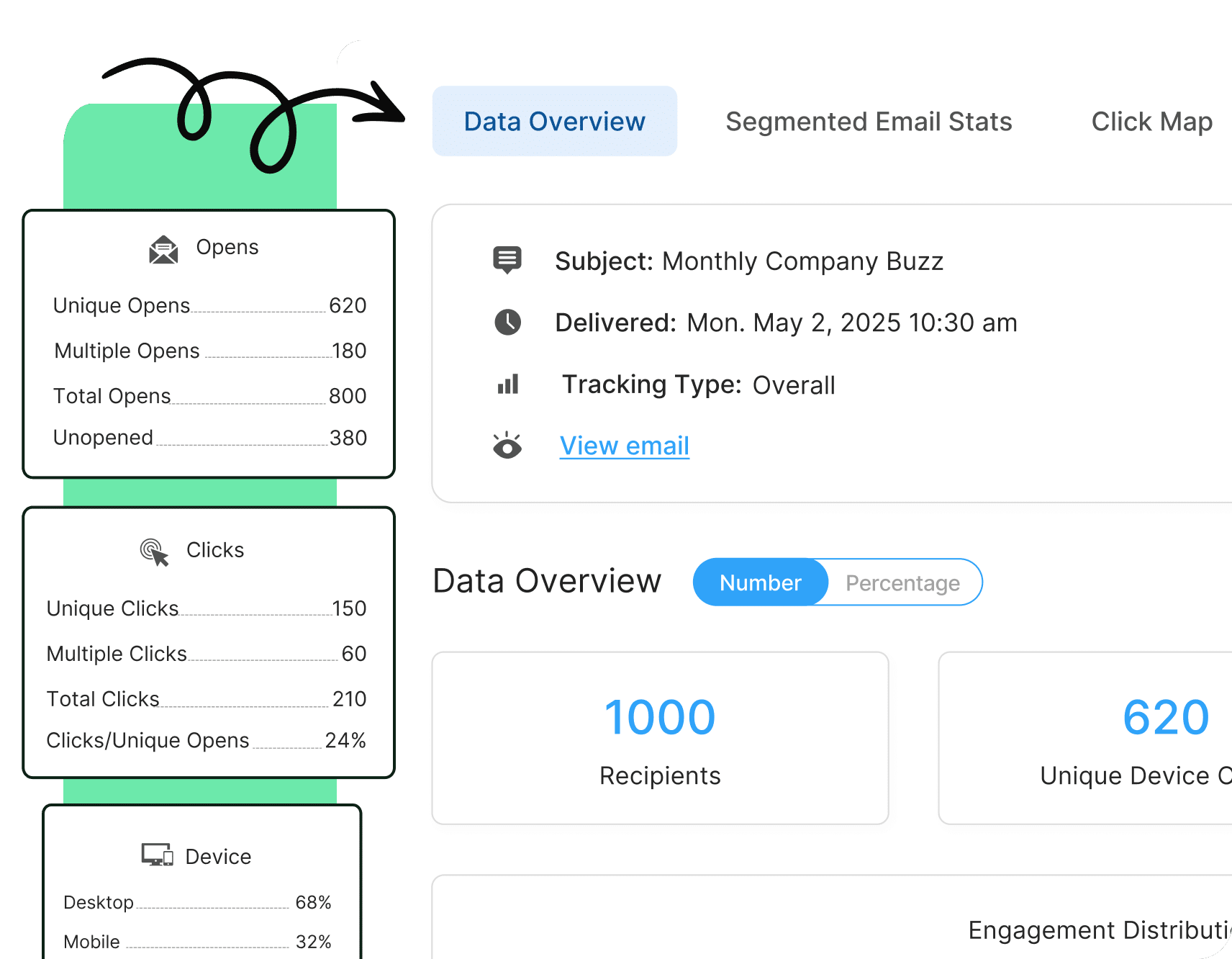
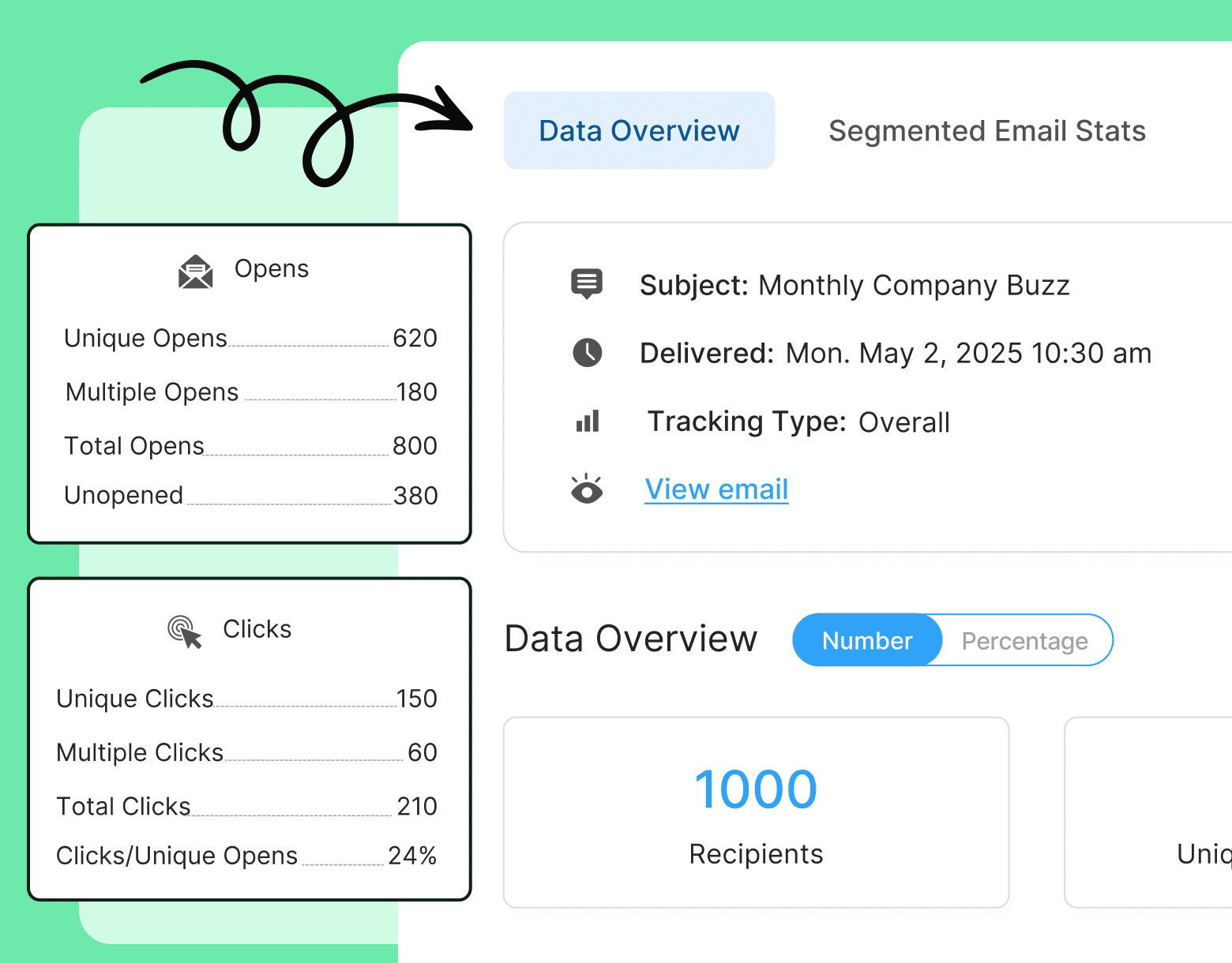
Why Is It Important to Establish and Measure Employee Engagement KPIs?
Establishing and measuring employee engagement KPIs is more than just a reporting task. It’s a strategic tool for improving workforce connection and performance.
Tracking the right employee engagement KPI examples allows you to:
- Catch problems early, like low participation in employee engagement surveys, which may signal communication breakdowns.
- Prove the ROI of your internal comms and of your engagement initiatives.
- Link employee engagement KPIs directly to business outcomes like productivity and retention.
- Give leadership clear data on what’s working—and where support is needed.
In short, if you work in internal communications, employee engagement analytics are your best friend.
With the right employee engagement software, you can automatically track these internal comms or HR metrics for employee engagement, identify patterns across time and teams, and continuously optimize your communication strategy.
Top 10 Employee Engagement KPIs to Track in 2025
We’ve broken these down into leading and lagging indicators—plus a few that bridge both.
Leading indicators: Predictive signals of engagement
These show you what’s likely to happen. They help you act before disengagement becomes a crisis.
1. Onboarding engagement rate
Tracks how actively new hires engage with onboarding materials and touchpoints during their first 90 days.
Why it matters: Early engagement often sets the tone for long-term satisfaction and productivity.
How to measure this employee engagement KPI: Track email open rates, training completion rates, and first login timestamps for onboarding platforms.
Example: If only 60% of new hires complete assigned onboarding within 10 days, it may point to information overload or poor delivery.
How to improve this metric:
- Segment onboarding content by role or department.
- Use automated reminders through your employee engagement software.
- Add peer introductions or mentor programs.
PRO TIP: Use our platform to automate personalized onboarding flows and track real-time engagement across cohorts.
2. Internal email open rate
Measures the percentage of employees who open internal emails sent through tools like ContactMonkey.
Why it matters: Low open rates mean employees might be missing critical updates, which can hurt awareness and alignment.
How to measure this employee engagement KPI: Email open rate = (Opened emails ÷ delivered emails) × 100.
Example: If your DEI update had a 38% open rate while your benefits update hit 74%, you’ve got insight into what content matters more to your employees.
How to improve this metric:
- Use personalized subject lines.
- Optimize send times by employee time zone.
- Segment communications by role or location.
PRO TIP: Use ContactMonkey to test subject lines, preview emails by audience segment, and track open rates in real time through the Analytics Dashboard Feature.
Start two-way conversations and employee feedback loops
Learn how to engage staff with pulse surveys, content ratings and reactions, custom polls, and more. Ready to send modern emails?
See engagement features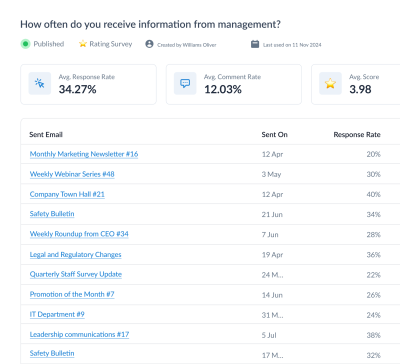
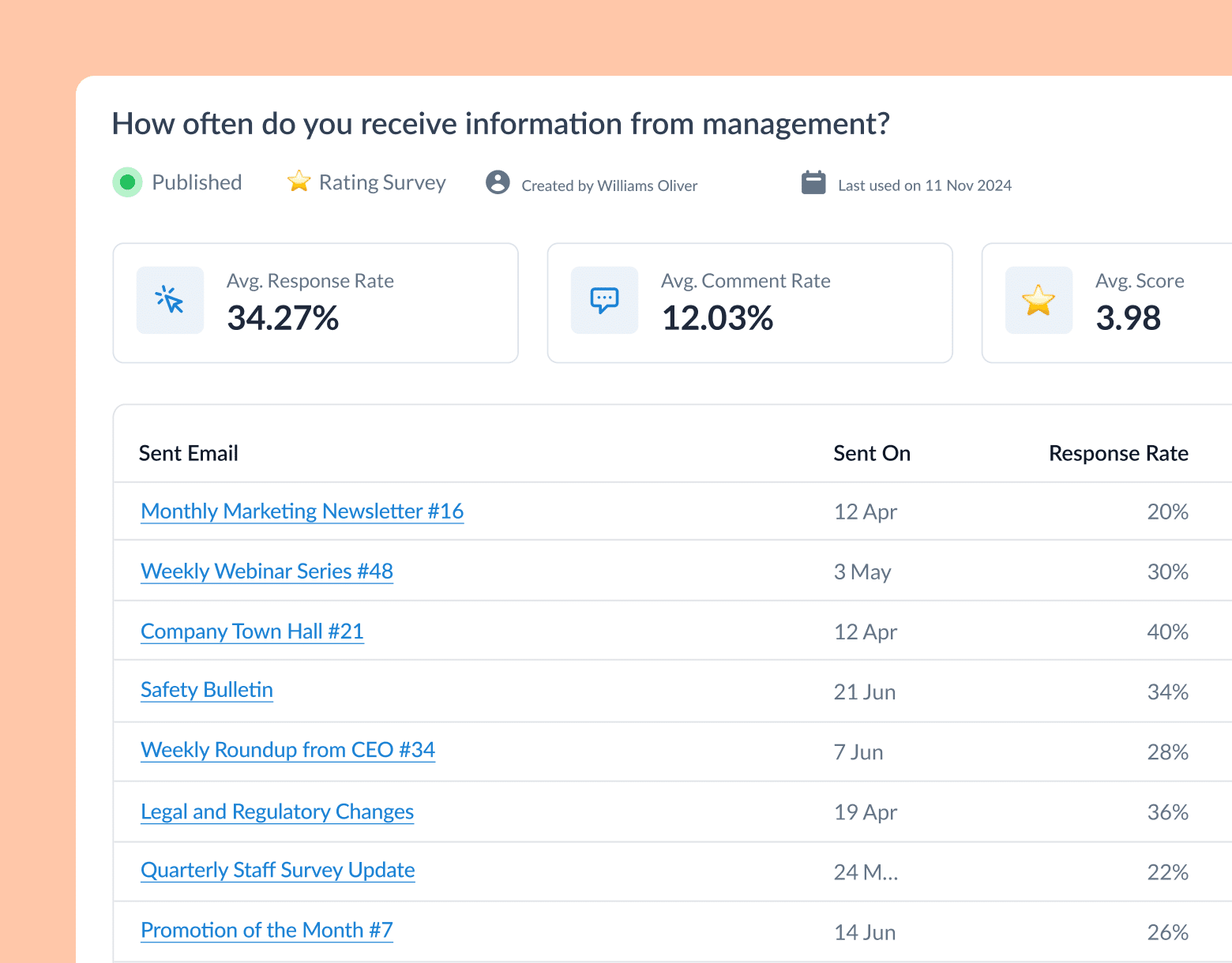
3. Pulse survey participation rate
Measures how many employees respond to regular, short-form employee engagement surveys.
Why it matters: High participation signals trust, interest, and a strong feedback culture.
How to measure this employee engagement survey KPI: Participation rate = (Number of responses ÷ number of employees invited) × 100.
Example: A 75% participation rate may reflect strong interest; anything under 40% could indicate survey fatigue or disengagement.
How to improve this metric:
- Keep surveys short (3–5 questions max).
- Embed surveys into internal emails.
- Communicate results and next steps clearly.
PRO TIP: Use employee engagement tools like the ones available through our Employee Feedback Features to automate survey delivery and follow-up messaging within one platform.
4. Email click-through rate (CTR)
Measures how many people clicked on links or CTAs in your internal emails.
Why it matters: High CTR shows employees are taking action, not just skimming updates.
How to measure this employee engagement KPI: CTR = (Number of clicks ÷ number of opens) × 100.
Example: A pulse survey embedded in your newsletter gets a 25% CTR—double your usual rate. That’s a great signal of engagement.
How to improve this metric:
- Keep CTAs visible and clear.
- Use dynamic content blocks to personalize.
- Link to valuable or interactive content (e.g., polls, videos).
PRO TIP: Through the Analytics Dashboard Feature, track clicks per employee segment to find out who’s engaging and where.
5. Email read time
Measures how long employees spend reading your emails—a powerful behavioral indicator.
Why it matters: This employee engagement KPI helps distinguish whether messages are actually being absorbed.
How to measure this employee engagement KPI: Read time = Average duration (in seconds) the email is open per recipient
Example: A new policy email shows a 40% skim rate (<5 seconds) and only 20% deep reads (>30 seconds). You likely need to simplify the message.
How to improve this metric:
- Use scannable layouts with bullet points.
- Add visuals or infographics to aid readability.
- Break long emails into digest-style series.
Watch ContactMonkey LIVE in action
Join live demo
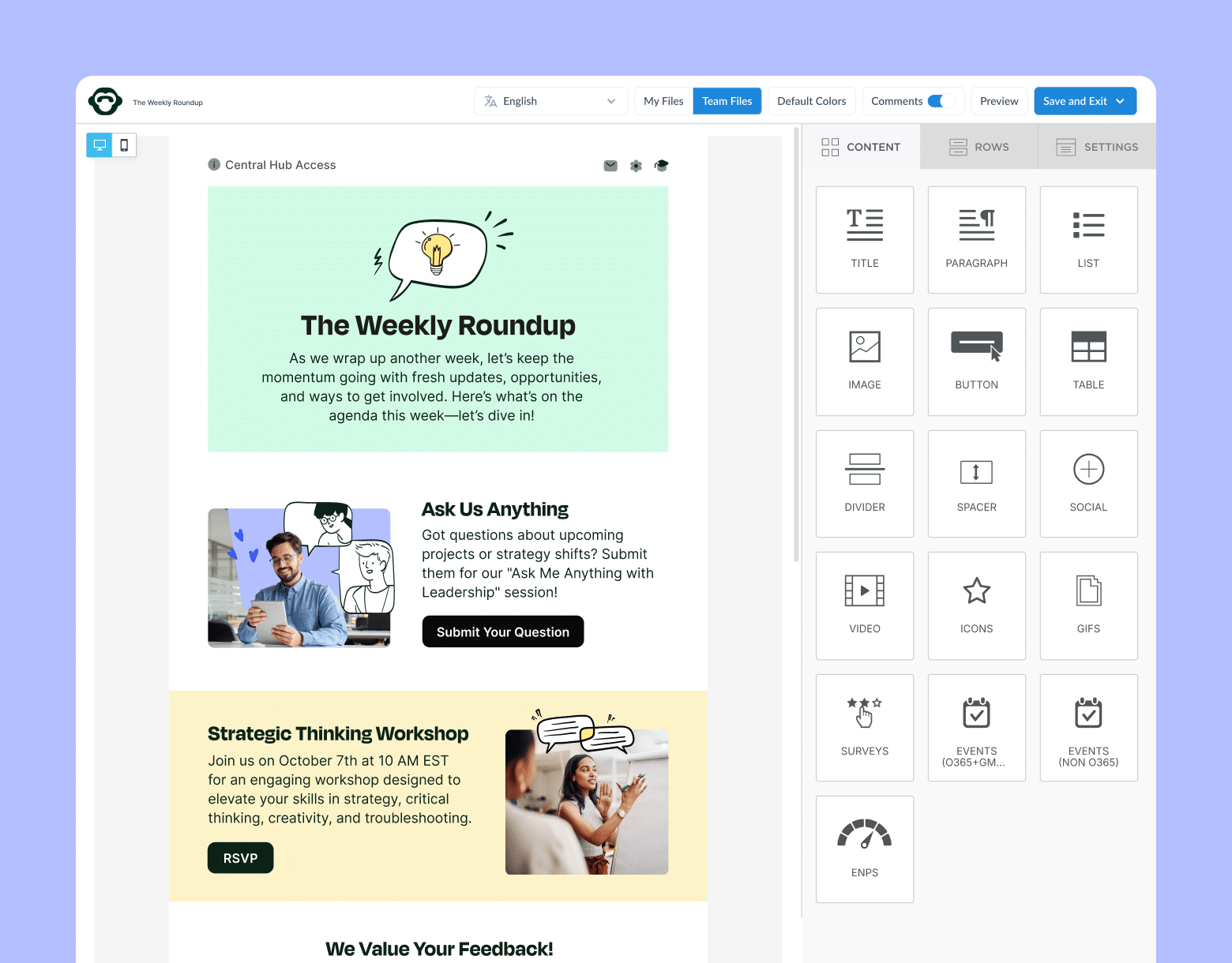
Lagging KPIs: Outcome-based metrics
Consider that these KPIs reflect engagement levels over time. These show the results of your employee engagement strategies. They reflect what has already happened.
6. Turnover rate
The percentage of employees who leave the company—voluntarily or involuntarily—within a given period.
Why it matters: High turnover often points to culture problems, low morale, or disengagement.
How to measure this employee engagement KPI: (Total exits ÷ average number of employees) × 100
Example: A 28% annual turnover rate in a specific department may suggest misalignment with leadership or role expectations.
How to improve this metric:
- Improve onboarding and early support.
- Create clear growth pathways.
- Conduct exit and stay interviews.
PRO TIP: Pair turnover data with employee engagement survey KPIs to find hidden patterns behind attrition. And, take advantage of this employee engagement survey results action plan guide to find out how to turn feedback into action.
7. Absenteeism rate
Tracks unplanned absences and sick days across the workforce.
Why it matters: Increased absenteeism can signal burnout, disengagement, or mental health concerns.
How to measure this employee engagement KPI: (Total unplanned absences ÷ total scheduled workdays) × 100
Example: A 9% absenteeism rate for one team is nearly double the company average—time to investigate.
How to improve this metric:
- Launch wellness or burnout prevention programs.
- Educate managers on mental health support.
- Normalize taking personal days.
PRO TIP: Use data from your employee engagement platform to detect absenteeism patterns across roles or regions.
8. Internal mobility rate
Measures how often employees are promoted or transferred within the company.
Why it matters: A strong signal of growth culture and internal opportunity—both key drivers of employee engagement.
How to measure this employee engagement KPI: (Internal moves ÷ total employees) × 100
Example: If 12 out of 150 employees change roles in six months, your mobility rate is 8%.
How to improve this metric:
- Create job shadowing or mentorship programs.
- Post internal roles before external ones.
- Recognize internal promotions publicly.
PRO TIP: Share success stories in your internal comms to reinforce upward momentum.
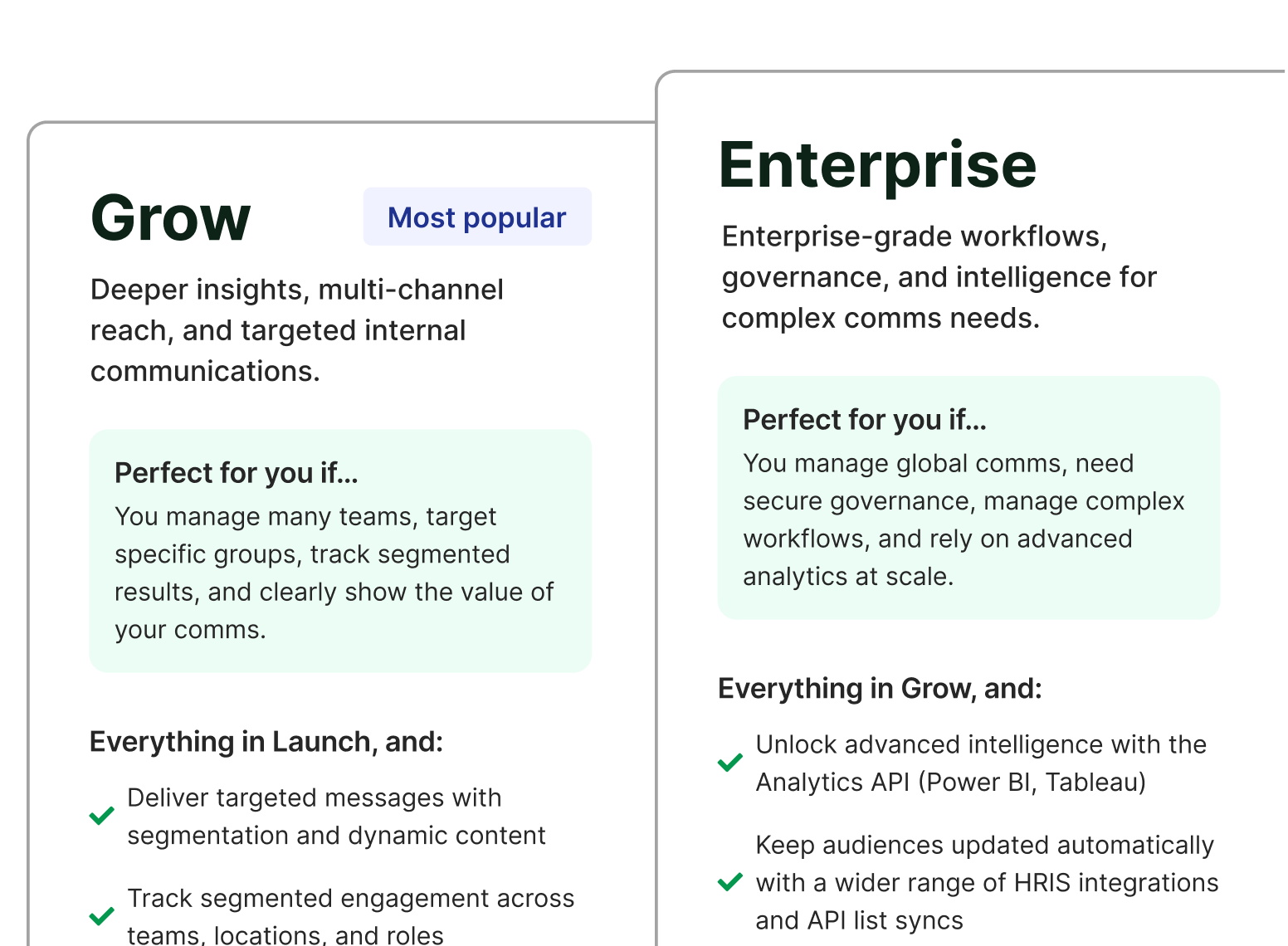
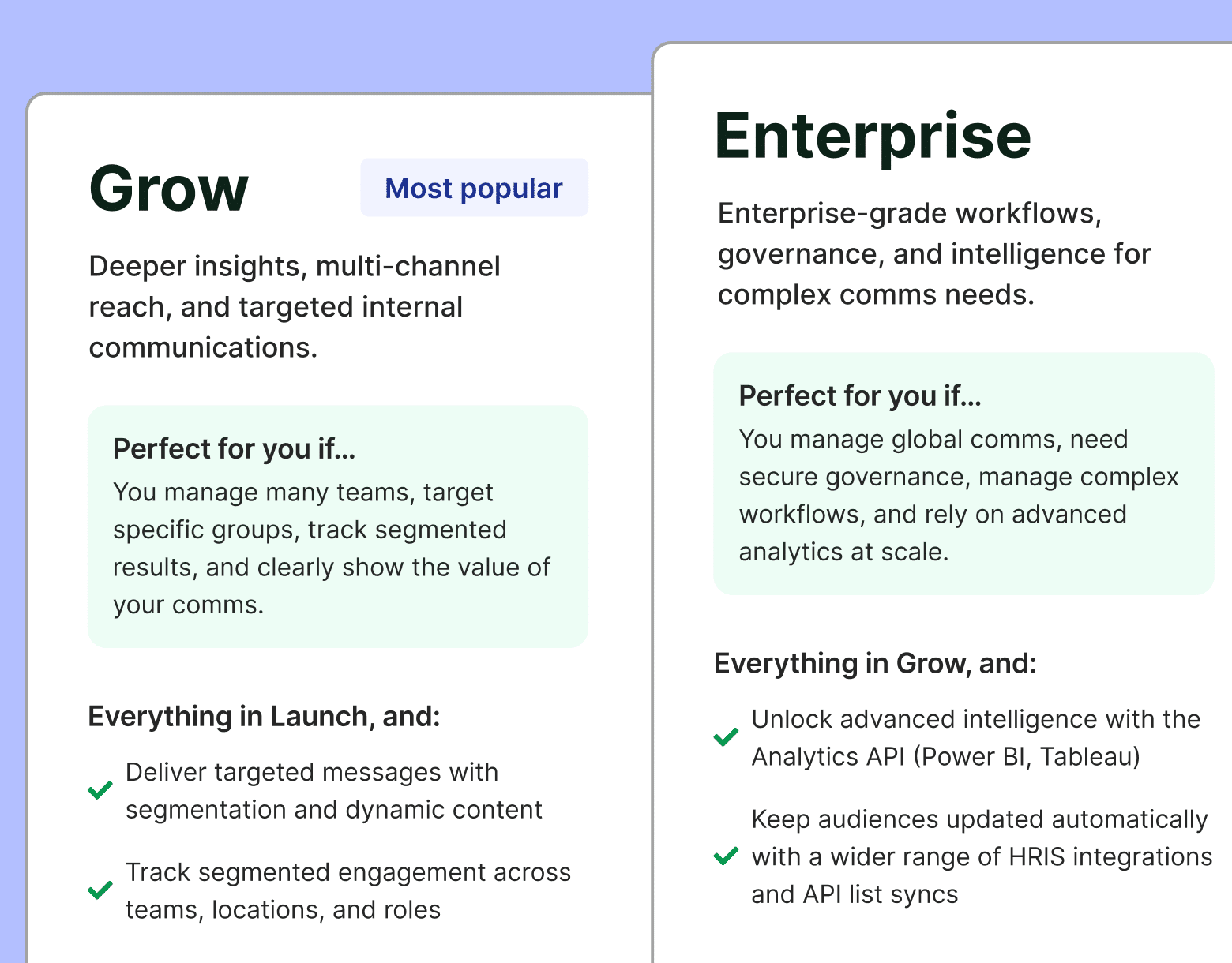
9. Employee satisfaction score
Reflects how content employees feel in their roles and with the company overall.
Why it matters: Satisfaction is foundational to measuring employee engagement KPI performance over time.
How to measure this employee engagement KPI: Survey question: “How satisfied are you with your job?” rated 1–5 or 1–10
Example: A satisfaction score of 3.2 out of 5 may point to unclear expectations or poor management.
How to improve this metric:
- Provide manager training.
- Clarify roles and responsibilities.
- Offer more frequent recognition.
PRO TIP: Ask open-ended follow-up employee engagement survey questions for deeper insights, and use AI sentiment tools to spot trends.
10. Retention rate
The percentage of employees who stayed with the company over a specific time frame.
Why it matters: High retention often reflects meaningful work, growth opportunities, and effective communication.
How to measure this employee engagement KPI: ((Employees at end of period – new hires) ÷ starting employees) × 100
Example: A 94% retention rate in your engineering team is a good sign—especially compared to a 78% company-wide average.
How to improve this metric:
- Highlight career progression stories.
- Recognize team contributions.
- Build internal mobility programs.
PRO TIP: ContactMonkey helps you track engagement trends over time, allowing you to predict retention risks before they happen.
Step-by-step: How to use ContactMonkey for Employee Engagement KPIs
Tracking the right employee engagement KPIs is only one piece of the puzzle. You need the right tools to make those insights actionable and actually improve metrics like retention, satisfaction, and feedback participation.
Here’s how to use ContactMonkey for employee engagement KPIs:
Step 1: Align KPIs to your goals, not just your metrics
Before you dive into dashboards, start by aligning your employee engagement KPIs with your internal comms objectives. Are you trying to reduce turnover? Increase transparency? Boost manager feedback loops? Let your business goals shape what you measure.
Instead of just listing metrics, ask:
- What behaviors do we want to influence?
- What questions are employees not answering?
- Which departments or teams are struggling with engagement?
PRO TIP: Use past campaign results to set a baseline, then choose 3–5 KPIs to track over the next quarter. Focus on quality over quantity.
Modern internal comms and measurement tools
No design or technical expertise needed. Save time, increase engagement, and dazzle your employees with fun and interactive communications.
Explore all features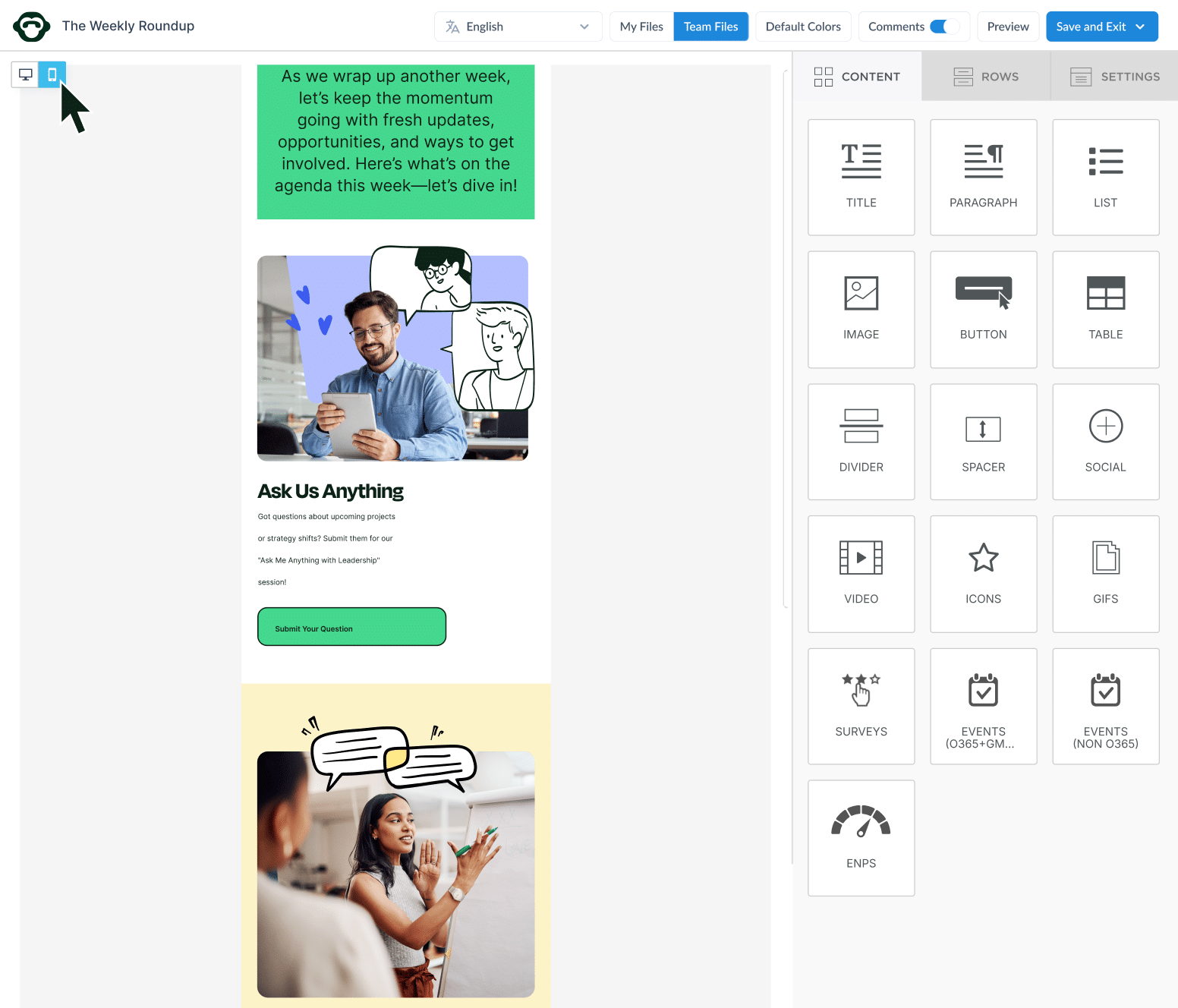
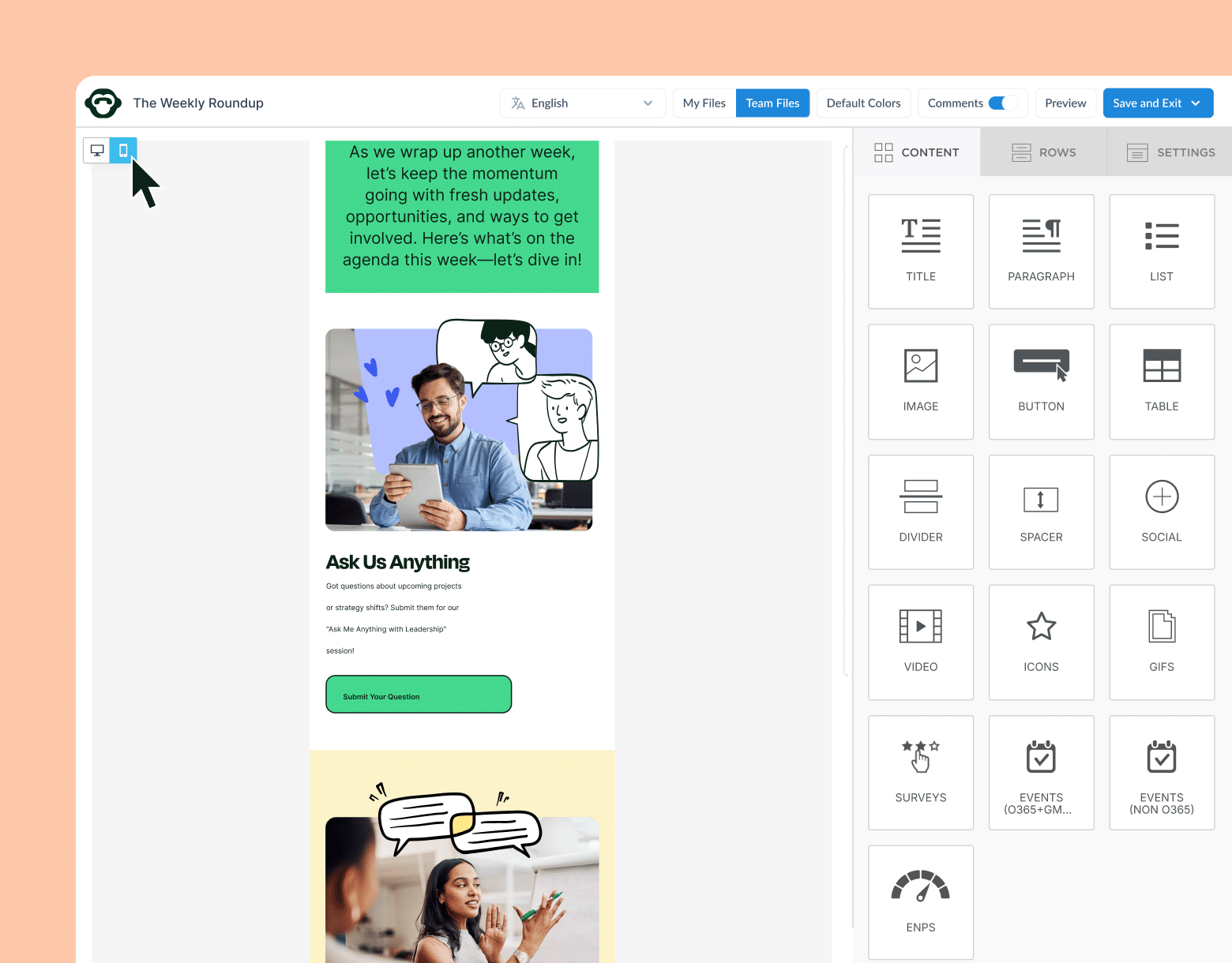
Step 2: Segment your audience
By tailoring your internal communications based on role, region, or even language, you make your messages more relevant—and your employee engagement KPIs stronger.
Use ContactMonkey’s audience segmentation features to group employees by:
- Department (HR, Sales, IT, etc.)
- Location or region
- Employment type (FTE, contractor, new hire)
- Language preference
PRO TIP: Want only FTEs to receive benefits info? Use the Dynamic Content Feature and rules to target them without sending multiple emails.
Step 3: Build emails with engagement in mind
Use our drag-and-drop Email Template Builder Feature to create responsive, engaging internal comms.
Add elements like:
- Embedded pulse surveys
- Quick polls or emoji reactions
- Event RSVPs
- Dynamic content blocks based on audience segment
PRO TIP: Add a “Based on your feedback…” section to showcase how employee feedback leads to real change.
Step 4: Schedule and personalize delivery
Use smart scheduling and audience segmentation for internal comms to deliver internal emails at the most relevant time for each group—whether they’re in different departments, roles, or regions.
Benefits:
- Improves email open rates by aligning with employee routines.
- Reduces message fatigue by avoiding off-hour sends.
- Shows respect for different work patterns and time zones.
PRO TIP: Use our scheduling tools to set up automated sends for onboarding, benefit reminders, or employee recognition—ensuring messages land when they’re most likely to be read.
Step 5: Track performance in real time
Once your email is sent, use our analytics dashboard to monitor:
Employee engagement KPI examples tracked:
- Open rate (by audience group)
- Click-through rate
- Read time (skim, glance, or deep read)
- Survey completion rate
- Feedback trends over time
PRO TIP: Filter results by department to identify where engagement is strong, and where support is needed.
TL;DR: Why Use ContactMonkey for Employee Engagement KPIs?
- It integrates with Outlook and Gmail (you don’t have to leave your inbox!).
- No IT support needed.
- Real-time engagement tracking.
- Integrated employee engagement survey KPIs.
- Powerful audience segmentation and personalization.
Ready to improve employee engagement? It starts by booking a 15-minute call with one of our experts who will get to know your needs and show you how the platform can meet them. Get start, today!


